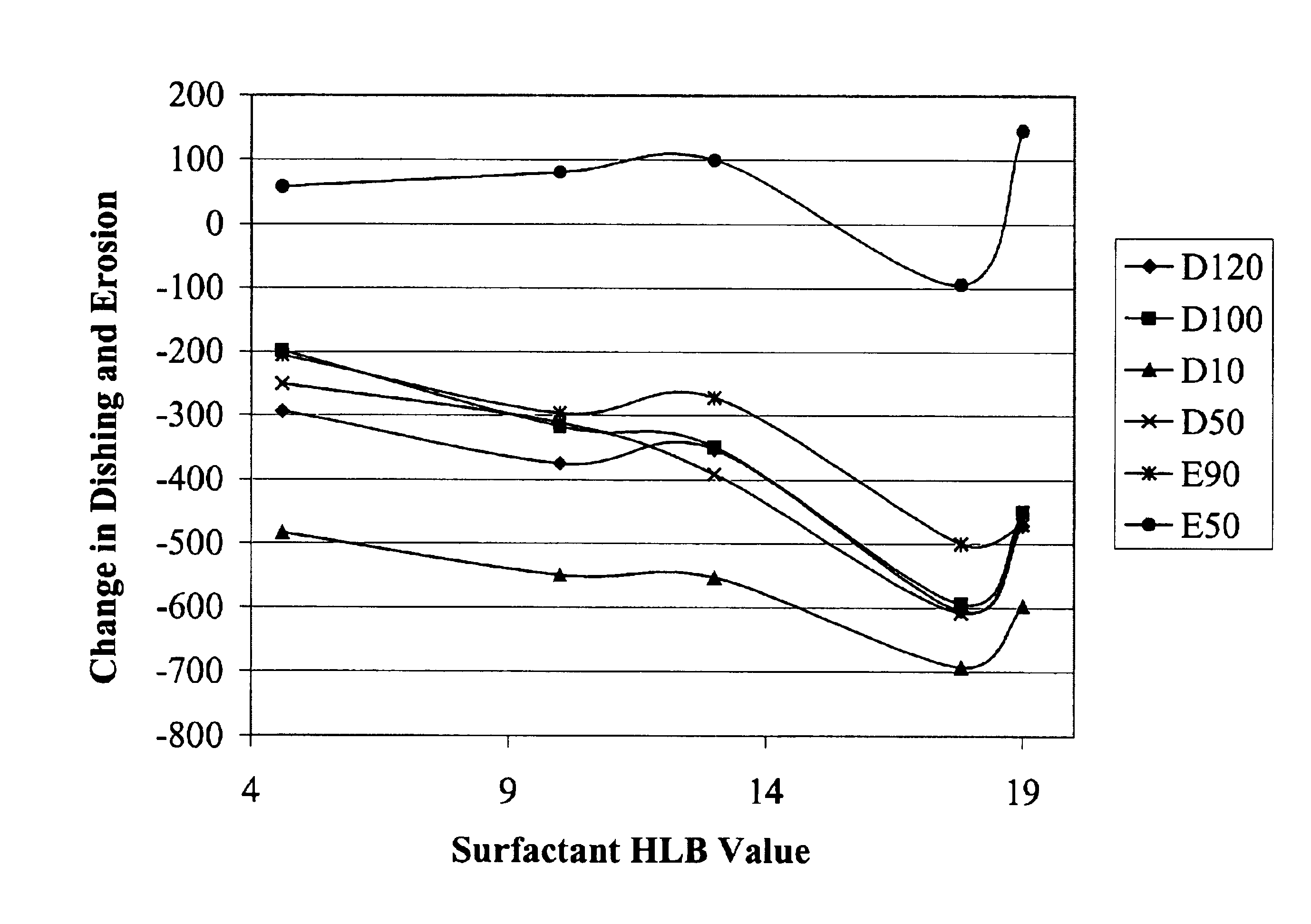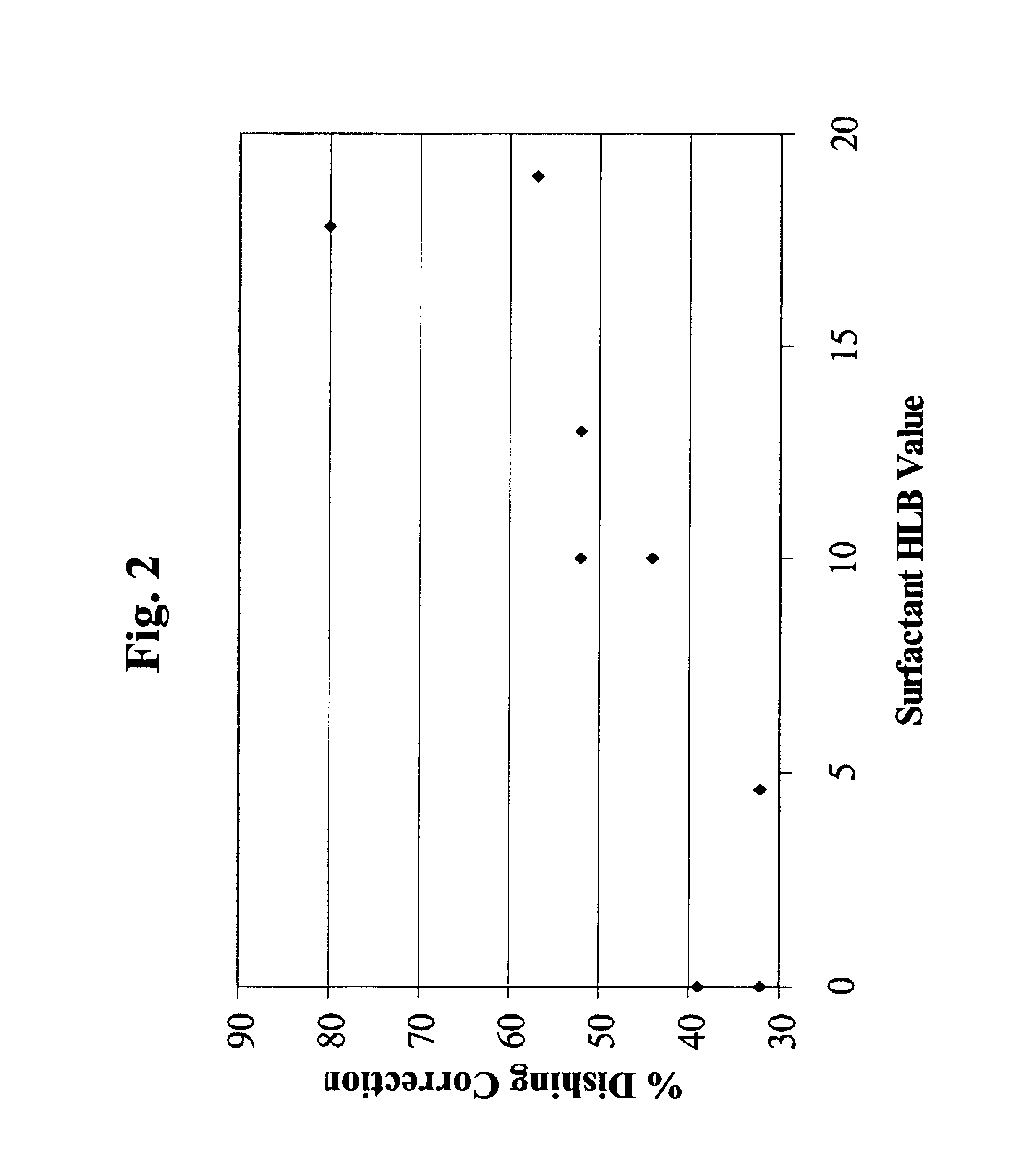CMP method utilizing amphiphilic nonionic surfactants
a non-ionic surfactant, amphiphilic technology, applied in the direction of polishing compositions, other chemical processes, chemistry apparatus and processes, etc., can solve the problems of limiting the speed (frequency) at which a circuit can operate, copper layers are easily over-polished, and their dielectric constant is relatively high
- Summary
- Abstract
- Description
- Claims
- Application Information
AI Technical Summary
Benefits of technology
Problems solved by technology
Method used
Image
Examples
example 1
[0050]This example illustrates the effect of amphiphilic nonionic surfactants in polishing compositions on copper dishing and erosion values as a function of surfactant HLB value.
[0051]Similar patterned substrates containing copper, tantalum, and silicon dioxide (Sematech 931 mask wafers) were polished with different polishing compositions (Polishing Compositions 1A-1E). Each of the polishing compositions contained 12 wt. % condensation-precipitated silica, 0.10 wt. % benzotriazole, 0.30 wt. % acetic acid, 3 wt. % hydrogen peroxide, and 200 ppm surfactant with a pH of about 10 (adjusted with KOH). Polishing Compositions 1A (comparative) and 1B-1E (invention) contained polyoxyethylene(2)isooctylphenyl ether having an HLB of 4.6, polyoxyethylene(5)isooctylphenyl ether having an HLB of 10, polyoxyethylene(9)nonylphenyl ether having an HLB of 13, polyoxyethylene(40)nonylphenyl ether having an HLB of 17.8, and polyoxyethylene(100)nonylphenyl ether having an HLB of 19, respectively. The c...
example 2
[0055]This example illustrates the effect of amphiphilic nonionic surfactants in polishing compositions on copper dishing and erosion values as a function of surfactant concentration.
[0056]Similar patterned substrates containing copper, tantalum, and silicon dioxide (Sematech 931 mask wafers) were polished with different polishing compositions (Polishing Compositions 2A-2D). Each of the polishing compositions contained 12 wt. % condensation-precipitated silica, 0.10 wt. % benzotriazole, 0.30 wt. % acetic acid, and 3 wt. % hydrogen peroxide with a pH of about 10 (adjusted with KOH). Polishing Compositions 2A-2D (invention) further contained 0, 100, 125, and 250 ppm of 2,4,7,9-tetramethyl-5-decyne-4,7-diol ethoxylate surfactant, respectively. The percent dishing correction for the 50 μm line region of the patterned substrate was measured for each of the polishing compositions.
[0057]A plot of the % copper dishing correction for the 50 μm line as a function of surfactant concentration i...
example 3
[0059]This example demonstrates that the presence of amphiphilic nonionic surfactants in the polishing compositions of the invention can be used in first step copper polishing for bulk copper removal.
[0060]Similar blanket wafer substrates comprising copper, tantalum, or silicon dioxide were polished with different polishing compositions (Polishing Compositions 3A-3F). Polishing Composition 3A (control) contained 0.7 wt. % lactic acid, 1.11 wt. % polyacrylic acid, 0.111 wt. % benzotriazole, 3 wt. % hydrogen peroxide, and 0.556 wt. % fumed alumina coated with polystyrenesulfonic acid (0.5 wt. % alumina and 0.052 wt. % polystyrenesulfonic acid) at a pH of 4.5 with no amphiphilic nonionic surfactant. Polishing Compositions 3B-3E (invention) were the same as Polishing Composition 3A, except that they further comprised 0.02 wt. %, 0.05 wt. %, 0.075 wt. %, and 0.10 wt. % polyalkyleneoxide-modified polydimethylsiloxane surfactant (HLB ˜13-17), respectively. Polishing Composition 3F (inventi...
PUM
| Property | Measurement | Unit |
|---|---|---|
| mean primary particle size | aaaaa | aaaaa |
| mean particle size | aaaaa | aaaaa |
| mean particle size | aaaaa | aaaaa |
Abstract
Description
Claims
Application Information
 Login to View More
Login to View More - R&D
- Intellectual Property
- Life Sciences
- Materials
- Tech Scout
- Unparalleled Data Quality
- Higher Quality Content
- 60% Fewer Hallucinations
Browse by: Latest US Patents, China's latest patents, Technical Efficacy Thesaurus, Application Domain, Technology Topic, Popular Technical Reports.
© 2025 PatSnap. All rights reserved.Legal|Privacy policy|Modern Slavery Act Transparency Statement|Sitemap|About US| Contact US: help@patsnap.com



